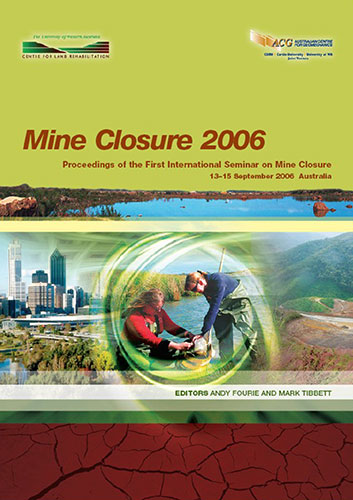The Economic and Social Aspects of Mine Closure at the Coal Mines of Kerman in Iran

|
Authors: Saeedi, G; Osanloo, M; Shahriar, K; Bakhtavar, E+E1709 Paper is not available for download Contact Us |
DOI https://doi.org/10.36487/ACG_repo/605_72
Cite As:
Saeedi, G, Osanloo, M, Shahriar, K & Bakhtavar, E+E1709 2006, 'The Economic and Social Aspects of Mine Closure at the Coal Mines of Kerman in Iran', in AB Fourie & M Tibbett (eds), Mine Closure 2006: Proceedings of the First International Seminar on Mine Closure, Australian Centre for Geomechanics, Perth, pp. 811-818, https://doi.org/10.36487/ACG_repo/605_72
Abstract:
To be considered as sustainable state, a mining community needs to adhere to the principles of ecological sustainability, economic and social equity. These principles apply over a long time span, covering both the life of the mine and post-mining closure. Globally and domestically, the politics of mining are increasingly being played out at the local community level, monitored closely by a variety of media and non governmental organizations around the world. Investors, insurance companies, banks, governments, and citizens increasingly want little to do with an industry that is seen as indifferent to the present and future socio-economic and biophysical welfare of local communities. This is a message that has been communicated loudly by international organization, such as the international council on metals and the environment (ICMM) and the World Bank. Mining companies must now pursue their interests in a way that also promotes those of the local communities in regions where they are operating. The long-term sustainability and visibility of both the mining industry and its related communities justifies serious attention. Improving environmental performance and mitigating environmental impacts of mining are critical, but will not necessarily suffice to ensure the social health and welfare of associated communities (Veiga et al., 2001). It is necessary, therefore, to go further in considering what sustainability entails in the context of the mining. Communications, education, cooperative decision-making and diversification are all important elements in long-term community sustainability. The objective of this research is to attempt to highlight reasons of mine closure and the adverse social and economic effects of mine-closure in the coal mines of Kerman in Iran.
References:
Laurence, D.C. (2005) Optimisation of the mine closure process, Cleaner Production,Elsevier Ltd, No14, pp. 285-298.
Roberts, S., Veiga, M. and Peiter, C. (2000) Overview of Mine-Closure and Reclamation in the Americas, Mining
Policy Reserch Inttiatives, October 2000, pp. 10-26.
Roberts, A. and Shaw, S. (1999) Mine Closure, the Center for Mine Land Redevelopment, pp. 5 to 6.
Veiga, M., Scoble, M. and Mcallister, M.L. (2001) Mining with Communitions, Elsevier Science LTD, pp. 191-202.
Social Impacts
Mine Closure 2006, Perth, Australia 817
Warhurst, A. (2000) Issues in the Management of the Socioeconomic Impacts of Mine closure: A Review of Challenges
and Constraints. In Environmental Policy in Mining, Warhurst, A. and Noronha, L., Ed., Lewis Publishers, Boca
Raton, pp. 81-99.
Kerman Coal Mines Company (2005) Statistical reports of Kerman’s coal mines.
Geological Survey of Iran, Seismotectonic Group (2005) Report.
Ministry of Industries and Mines of Iran (2005) Report.
The Economic and Social Aspects of Mine Closure at the Coal Mines of Kerman in Iran G. Saeedi, et al.
818 Mine Closure 2006, Perth, Australia
© Copyright 2025, Australian Centre for Geomechanics (ACG), The University of Western Australia. All rights reserved.
View copyright/legal information
Please direct any queries or error reports to repository-acg@uwa.edu.au
View copyright/legal information
Please direct any queries or error reports to repository-acg@uwa.edu.au